Patellar tendinitis or jumper’s knee is a common knee joint issue. It’s due to overuse and is marked by pain, weakness, and swelling. The problem comes from hurting the patellar tendon, which links the kneecap to your upper shin.
Doing sports like running, jumping, or kicking can lead to this knee condition. So can getting hit directly on the knee. Not being strong or flexible enough in the thigh and knee, having flat feet, or suddenly pushing yourself too hard in sports are also risk factors.
The key signs are pain, tenderness, and swelling. You might hear a crackling noise when you move the tendon. Also, it could be hard to fully straighten or bend your knee. Without treatment, it can get worse and might even need surgery.
But there’s good news. Stem cell therapy is a treatment option that doesn’t need surgery. It uses stem cells from your own body to help heal. This approach can repair damaged tissues, lower swelling, and speed up your recovery.
Key Takeaways:
- Patellar tendinitis or jumper’s knee causes pain, weakness, and swelling in the knee.
- It’s often due to overuse and activities like running or jumping.
- Getting hit on the knee, not being strong or flexible enough, having flat feet, or overdoing exercise suddenly increases the risk
- Signs of patellar tendinitis are pain, swelling, and trouble moving your knee.
- Stem cell therapy can heal your knee with your own stem cells, reducing the need for surgery.
Causes and Diagnosis of Patellar Tendinitis
Patellar tendinitis, or jumper’s knee, comes from overuse or repeated injury to the patellar tendon. People who jump or run a lot usually face this. Sports like basketball, volleyball, and track carry a big risk. So does getting hit on the knee and running downhill.
Not being strong enough or flexible in the thigh and knee can also make this more likely. Weak thigh muscles, mainly the quadriceps, put too much stress on the tendon. Poor knee flexibility can do the same.
Also, ramping up training too fast can stress the patellar tendon too much. It becomes more vulnerable to damage and swelling. Athletes must step up their training slowly to prevent this.
Diagnosing patellar tendinitis involves checking the knee physically and using images. A health pro looks for signs like pain, tenderness, and swelling. They might hear some strange sounds, too.
X-rays, MRIs, and ultrasounds are key for a thorough diagnosis. X-rays are great for checking the bones. MRIs show details of the knee’s soft tissues, helping spot tendon issues. Ultrasounds give a live view of the tendon, which can show if it’s inflamed, thicker than normal, or torn.
Summary:
Jumping and running a lot can lead to patellar tendinitis. So can getting hit on the knee and running downhill. Weak thigh and knee muscles and sudden hard training also play a role. Diagnosis is usually based on common signs like pain, and it often involves imaging tests. These tests help see how serious the tendon’s condition is.
Treatment Options for Patellar Tendinitis
When treating patellar tendinitis, doctors offer many options. These range from simple care to new, cutting-edge treatments. The best choice varies with how bad the condition is and what the patient needs.
For starters, methods without surgery are important for this issue. You might change activities to ease stress on your patellar tendon. Exercises can keep your leg strong and ease the pain. Physical therapy also helps build up knee-supported muscles. Hot and cold packs plus knee braces can reduce swelling and provide extra support.
Doctors can also give you medications like painkillers or NSAIDs to help control pain and swelling. But, if these non-surgical steps aren’t enough, surgery might be needed. It’s not very common, but it can repair major tendon damage and help you get better.
Some people look for different options. Stem cell therapy is becoming a favorite for treating patellar tendinitis. This method uses your own stem cells to heal and lessen swelling. It’s done in clinic injections and goes along with exercises to fight the root problem of the injury.

